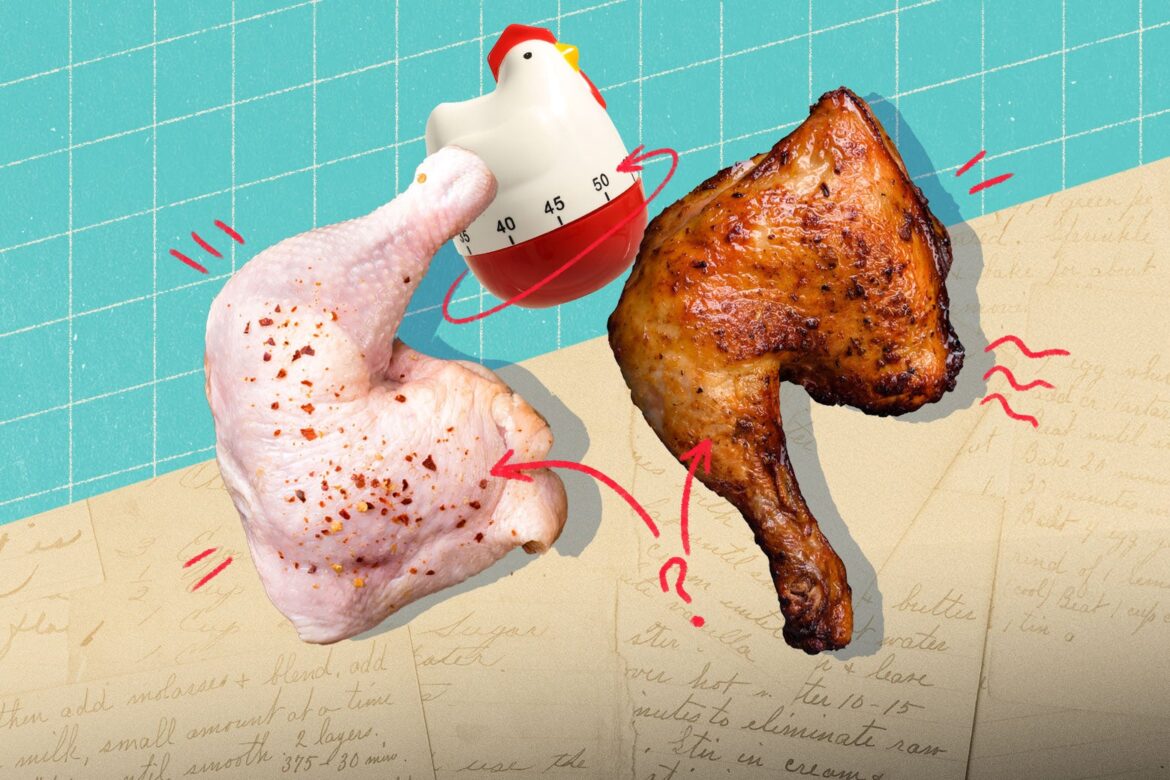Recipe for Disaster is Slate’s column about what recipes get wrong—and how to fix them. If you’ve noticed a recipe annoyance, absurdity, or outright lie, file your complaint here and we will investigate!
It’s getting harder and harder these days to separate fact from fiction. Case in point: Check out this video for “Honey Garlic Chicken Thighs,” in which bone-in, skin-on thighs are seared fast and hard in avocado oil, then simmered in a wet, steamy, sweet and spicy sauce. Watch with horror as the cook proclaims, “Oh my god, this is perfection. I can already tell you. I mean, it’s crispy on the outside, juicy on the inside, as promised.” This, friends, is a dump truck load of bullshit. That chicken skin isn’t crispy at all. How do I know? One, I can see. Her knife slides right through the chicken skin like a samurai sword going through a wet napkin, and two, she cooks the chicken thighs directly in the sauce, being sure to dunk the skin side into her honey-sriracha-soy concoction. That right there is a catastrophe sullying the good name of properly cooked poultry.
And this AllRecipes disaster isn’t an outlier: In so many recipes for skin-on chicken thighs and legs that promise a satisfying crunch, the skin never comes out crispy. Recipes that call for simmering chicken thighs or drums in a wet sauce are a huge red flag, and they’re all over the internet. They’ll instruct cooks to make a lovely, flavorful sauce, but too many of them apply that moisture directly to the chicken itself (whether by simmering or pouring the sauce on top). Follow these, and you’ll find yourself saying, “Wait a minute, this isn’t crispy at all.” And I’m here to tell you: It’s not your fault. It’s the recipe developers who have let you down.
So what’s going on here? Let’s start with the question of searing time, because there’s a ton of confusion about this in general. The All Recipes example above has us searing for 3 to 7 minutes per side. Over at New York Times Cooking, we’re going for 8 to 10 to crisp up that skin. And in some place called Kelly’s Clean Kitchen, it’s 15 to 20, starting with a cold skillet. They can’t all be right! Moreover, the comment sections in recipes for bone-in, skin-on chicken are generally filled with two types of criticisms: First, grease splatters everywhere. And second, the chicken skin, as we’ve established, is soggy. But there’s hope: It turns out that if you want to solve both of those problems at the same time, to finally achieve true crispy-chicken bliss, there’s a single, easy, chef-endorsed method to employ: unilateral cooking.
Unilateral cooking, a classic French technique, is a method where protein is cooked gently on one side. Never flipped. I repeat: NEVER FLIPPED. To hear chef Eric Ripert of New York City’s legendary La Bernardin explain it, “the heat comes from the bottom very slowly.” In the video linked above, he applies the method to salmon, which in turn produces a gorgeous color, delicate texture, and pure flavor. Ripert goes on to glow over the benefits of unilateral cooking: “You will be able to taste the fish fully, without any distraction of other ingredients.”
Another one of my favorite chefs, French master and former TV husband to Julia Child Jacques Pépin, applies the same technique to chicken. His wonderful recipe for crusty chicken thighs with mushroom sauce was tested over at Serious Eats by Nick Kindelsperger. It’s this unilateral method of cooking chicken thighs slowly and delicately that also produces an additional luxury—rendered chicken fat from the chicken skin. Kindelsperger reports:
[Pépin] just placed the pieces skin-side down in the skillet, turned the heat to high, and watched as the skin turned a glorious golden brown. Once sizzling, the skillet is covered, the heat is reduced to medium, and the chicken cooks until done. Pepin never flips or fiddles with it. How could this chicken be so easy? The only fat in the skillet is rendered from the chicken skin. By the end there is a surprising amount. Luckily, it’s used as the base for the quick pan sauce.
It’s a perfect method for cooking skin-on chicken. The chicken skin crackles and produces an almost hard candy-like texture when slowly searing in its own fat. To finish, just transfer the chicken to an oven for a few minutes, and use the chicken schmaltz (the fat from the rendered chicken skin) to make a sauce or save it for cooking vegetables, etc. I’ve been using a similar cold-pan unilateral method that I learned from a chef years ago. Here’s how it’s done:
I place bone-in chicken thighs skin-side down in a cold stainless-steel pan. Then, I turn the burner heat to low. Next, I wait. Patience is key here. If you’re trying it at home, first you’ll say to yourself, “Surely there’s no way chicken is going to cook on this low of heat.” But after a few minutes, it’ll start to sweat. Pour yourself a drink or black out briefly on TikTok. By the 20-minute mark, you’ll notice that the skin is actually frying in its own rendered fat. Be sure to not move the chicken. Finally, after about 40–45 minutes—yes!—the frying will be low but intense, and you’ll sense golden bits of skin around the chicken. Turn it over with a metal spatula (to stop the skin from overcooking) and pop the skillet into a 350-degree oven for 10 minutes to finish cooking everything through. The result? Darkly golden, crispy, crunchy chicken skin imbued with the flavor of its own fat. The flavor is clean, full, developed, and as chef Ripert puts it, undistracted.
Now listen, I understand that we’re leaving 30-Minute Meal Town and driving right into Hope You Have an Hour City, but I’ve never minded this cooking method. That’s because you literally don’t have to pay attention to the chicken skin as it cooks. It’s going to cook slowly and correctly for 45 minutes whether you stare at it or not. So, I often take it as an opportunity to fold laundry, file receipts, or anything else one considers busywork.
Just about every chef I interviewed about this also seems to favor unilateral cooking. “As a rule, I never sear the flesh side (on any poultry) and only apply dry heat to chicken/poultry skin, trying to poach the meat as gently as possible,” says Jesse Griffiths, author of the James Beard Award–winning The Hog Book and The Turkey Book (the guy knows meat) and chef/proprietor of Dai Due, in Austin Texas, in an email.
He continued, “One way I like to braise chicken thighs is to not brown them and cook them uncovered, skin-side up in the oven, essentially braising the (un-seared) flesh side while the exposed skin side roasts/renders for about an hour as they cook.” I tried Griffiths’ method with a few quarter-chickens (thigh, drumstick, and back), and it worked beautifully. However, I felt something was missing. It was the beautiful flavor, that undeniable texture achieved through slowly tempering chicken in its own fat. Griffiths’ dry oven method produced crispy chicken skin, but I felt like a slow, steady frying was better.
Chef Nicholas Ponte, of Salt & Smoke and McElroy Farms, also offered more tips for achieving delightful chicken skin. “The skin on the chicken must be dry, so this process actually starts at least 48 hours before cooking.” (Don’t close the tab! I know this is an insane prep time for chicken, but diligently starting something in advance is a surefire way to ensure a better end product. Save this method for special occasions, not weeknight dinners.) Ponte’s process begins by patting the chicken dry with paper towels. This is a hugely important step that Griffiths also corroborates. Chicken, especially packaged chicken you get from the grocery store, often arrives with a lot of moisture. It’s always necessary to pat it down with a paper towel, and if a recipe doesn’t instruct you to do that, well, they’re leading you into a swamp.
Ponte recommends a dry brining method for chicken: Score the layer of fat with a knife, salt, then let it sit in a fridge for 24 hours. Then, remove the salt, pat the chicken dry again, and let it dry uncovered in the fridge’s cold air for another 24 hours. Sheesh.
“The skin should be dry and tacky to the touch, and this is what will help achieve good crisp,” says Ponte. He recommends using a high-smoke-point oil like grass-fed beef tallow, and frying the chicken skin-side down on medium heat. Ponte is also a fan of unilateral cooking, recommending that one cook the chicken in a good amount of fat, skin-side down in a hot pan, then place it on a wire rack and sheet tray, where it can finish cooking in an oven at 350 degrees. It’s a lot of prep, but I tried it, and the results were as desirable, if not more so, than my cold-pan unilateral method. This was fried chicken without the flour—crunchy, charred around the edges, and shockingly crisp.

J. Bryan Lowder
The New York Times Once Faced a Rebellion Over This Deceptively Simple Recipe. Is It Still Worth Making Today?
Read More
When I Started Dancing in My 60s, I Wasn’t Prepared for What It Would Do to Me
My Teenage Crush Was Mystifying and All-Consuming. Decades Later, I Finally Understand Why.
This Content is Available for Slate Plus members only
Beer Is Officially on the Decline in America. No One Saw the Real Culprit Coming.
This Content is Available for Slate Plus members only
Barron Trump Is 6’7”. He Is 19. He Is an NYU Kid. He Certainly Is Not This.
And what to do with your chicken thighs when you achieve this crispness? Well, definitely don’t add moisture! Do not steam your chicken thighs in liquid, or place them skin-side down in a pan sauce. That’ll just ruin your crispy skin. “Preserving it can be tricky,” says Griffiths, “like with a roasted chicken. When carving, I take great lengths to not carve or cut the chicken with the skin on the cutting board, as even that quick pressure against the board creates steam and kills the crispiness.” Personally, I’m such a crispy-skin fanatic that I actually prefer no sauce with my chicken thighs. Adding moisture just isn’t worth the risk. That might sound boring, but a simple salt-and-pepper unilaterally seared chicken thigh with skin that’s been fried crispy in its own fat is a wonderful, natural delicacy full of concentrated poultry flavor. A perfect protein to pair with whatever else you might have lying in the fridge (hopefully some vegetables).
“I do think that chicken skin at its crispiest is worth fighting for,” Griffiths told me. Ironically, fighting for crispy skin is a delicate business. It’s a brawl, but one fought with discerning technique and a tender touch. The recipes that tell you to brutally fry chicken for under 10 minutes on high heat, oil splattering every which way on your stove? Or to simmer chicken in a roiling sauce, rendering the skin as sodden as patio furniture left out in a sudden squall of rain? Or the ones that don’t even have the decency to tell you to pat the chicken dry before frying—all while claiming their chicken is “pure perfection”? What they’re selling you isn’t proper cookery, it’s a shortcut that, predictably, produces shortcomings. And you and your chicken both deserve better than that.

Sign up for Slate’s evening newsletter.


Dining and Cooking